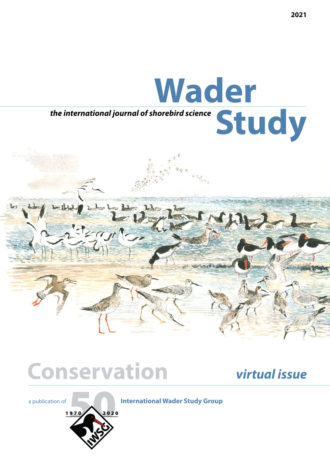Conservation

Cover: Drawing by Jens Gregersen, from WSGB 74 (special issue)
The conservation of endangered and declining species has long been of interest to ecologists from across the globe. Ever since the first Wader Study Group Bulletin (WSGB) was published in 1970, it has been used to explore and discuss the reasons why wader numbers were declining. Over the decades, the WSGB (later renamed Wader Study) has been used to publish key findings about the reasons for declines in many species, and to announce and discuss methods for their conservation. Here, we highlight some of the key issues that have been addressed in WSGB and Wader Study over the last 50 years.
In 1979, the proposed reclamation of the Nordstrander Bucht wetlands in the then West Germany was shared among the group, with a leaflet attached to the WSGB and a note by Peter Prokosch highlighting the high numbers of waders using the area (Prokosch 1979). Many shorebird species are entirely reliant on wetland habitats, which are far too often reclaimed or disturbed for various human activities, as you will see throughout this short editorial.
In 1983, Summers and Nicoll commented on the major threats to shorebirds in Iceland. The threat of the degradation and destruction of wetland habitats was reinforced, with articles published about the Taff Estuary suffering from road construction (Hinsley 1986) and the Drana Lagoon in the Evros Delta Ramsar Wetland being illegally blocked off by local farmers (Goutner & Jerrentrup 1987). Then, in 1988, there was a plea for more information about the incredibly scarce Slender-billed Curlew Numenius tenuirostris (Gretton 1988).
The threats posed by increased tourism and other human activities were again raised in the 1990s, for example, when Khrokov discussed wader conservation in Kazakhstan and suggested the creation of a wider network of nature reserves (Khrokov 1992). The following year, Koolhaas et al. (1993) discussed the effects of aircraft on foraging Knot Calidris canutus, in an issue that was dedicated to the influence of disturbance on waders.
In the 2000s, articles reflected the emergence of novel threats to wading birds. In 2003, an entire issue was dedicated to these, highlighting the looming effect of climate change (Smart & Gill 2003) and the emergence of renewable energies (e.g. wind farms) having the potential to lead to significant declines in bird numbers (Exo et al. 2003). There were also some positive articles published, including the discovery of a key shorebird site in the Upper Bay of Panama (Buehler et al. 2004) and about the benefits of banning off-road vehicles on South African beaches for breeding and wintering waders (Williams et al. 2004). Finally, at the end of the decade, another call for help to find the Slender-billed Curlew (Crockford 2009).
In 2010, Zöckler et al. (2010) suggested that declines in the population size of the Spoon-billed Sandpiper Calidris pygmeus were due to hunting pressures, and Sandilyan et al. (2010) reported a major decline in species-richness in mangrove wetlands in southern India. Currently, a major wetland in Portugal faces a big threat: a commercial airport is planned at the heart of the Tagus Estuary, an internationally important wetland in the East Atlantic Flyway. As has so often been the case, Wader Study was used as a platform to share concerns about this imminent threat and to discuss potential solutions (Alves 2020). The WSG deemed this threat so important that, during the 2020 Annual General Meeting, the board unanimously agreed to issue a statement opposing its development (find the statement here). There are many other papers about the conservation of waders that have been published in WSGB and Wader Study over its fifty-year history, highlighting the important roles that these journals have played.
Proposed Reclamation of Nordstrander Bucht, West Germany Peter Prokosch Volume 27. 1979 An Uncertain Future for Breeding Waders in Iceland R. W. Summers & M. Nicoll Volume 39. 1983 The Taff Estuary Under Threat S. Hinsley Volume 46. 1986 The Destruction of the Drana Lagoon in the Evros Delta Ramsar Wetland, and Its Consequences for Waterfowl V. Goutner & H. Jerrentrup Volume 50. 1987 Slender-Billed Curlews: Help Needed A. Gretton Volume 54. 1988 The populations, study and protection of waders in Kazakhstan V. V. Khrokov Volume 64. 1992 Disturbance of foraging Knots by aircraft in the Dutch Wadden Sea in August-October 1992 A. Koolhaas, A. Dekinga & T. Piersma Volume 68. 1993 Climate change and the potential impact on breeding waders in the UK J. Smart & J. Gill Volume 100. 2003 Birds and offshore wind farms: a hot topic in marine ecology K. M. Exo, O. Hüppop & S. Garthe Volume 100. 2003 Shorebird counts in the Upper Bay of Panama highlight the importance of this key site and the need to improve its protection D. M. Buehler, A. I. Castillo & G. Angehr Volume 105. 2004 Waders respond quickly and positively to the banning of off-road vehicles from beaches in South Africa W. A. J. Ward, V. L. Ward & L. G. Underhill Volume 104. 2004 Can you help find the Slender-billed Curlew? N. Crockford Volume 116-1. 2009 Hunting in Myanmar is probably the main cause of the decline of the Spoon-billed Sandpiper Calidris pygmeus C. Zöckler, T. H. Hla, N. Clark, E. Syroechkovskiy, N. Yakushev, S. Daengphayon & R. Robinson Volume 117-1. 2010 Major decline in species-richness of waterbirds in the Pichavaram mangrove wetlands, southern India S. Sandilyan, K. Thiyagesan & R. Nagarajan Volume 117-2. 2010 Perhaps the most prominent threat to waders in the East Atlantic Flyway J. A. Alves Volume 127-2. 2020
